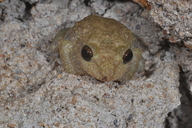|
Pseudophilautus fergusonianus (Ahl, 1927)
Ferguson's Tree Frog | family: Rhacophoridae subfamily: Rhacophorinae genus: Pseudophilautus |
 © 2011 Dr. Peter Janzen (1 of 19) |
|
|
|
Description In life, the dorsum and lateral head are brown and have symmetrical, dark-brown markings with white patches. The upper and lower flanks are brown and share a similar marking and patch coloration as the dorsum and lateral head. There are white markings on the dark brown inguinal zone. Dorsally, the limbs are brown with white dots and dark-brown crossbars. Posteriorly, the thigh is dark-brown. The coloration of the venter is pale brown. The webbing is dark-brown (Meegaskumbura & Manamendra-Arachchi 2005). In preservative, the dorsal side of the species is brown with symmetrical dark-brown markings. The interorbital bar is dark brown. The brown upper and lower flank present with dark brown and white patches. The dark brown inguinal zone has white markings. There are dark-brown patches located on the tympanic and loreal region. The tympanum is a yellowish brown color with the outer rim being brown. The mid-tympanum region is dark brown. The brown upper lip has white patches. Dorsally, the limbs are brown with white dots and dark brown crossbars. The posterior aspect of the thigh is dark brown. The venter is a pale yellowish-brown color. The webbing is dark brown (Meegaskumbura & Manamendra-Arachchi 2005). Distribution and Habitat Country distribution from AmphibiaWeb's database: Sri Lanka
Life History, Abundance, Activity, and Special Behaviors All frogs of this genus Pseudophilautus are known terrestrial direct developers (Bahir et al. 2005). Comments The species epithet of P. hallidayi had honored the 1994 International Director of the IUCN and SSC Task Force on Declining Amphibian Populations, Timothy Richard Halliday. His work consisted of research on amphibians and contributing to advancing the understanding of amphibian population decline worldwide (Meegaskumbura & Manamendra-Arachchi 2005). Pseudophilautus hallidayi and P. cavirostris are both sister species. A 12S and 16S divergence of 7.9% and 15.7% cyctochrome-b divergence test was used to differentiate these two species (Meegaskumbura & Manamendra-Arachchi 2005).
References
Bahir, M. M., Meegaskumbura, M., Manamendra-Arachchi, K., Schneider, C. J., and Pethiyagoda, R. (2005). ''Reproduction and terrestrial direct development in Sri Lankan shrub frogs (Ranidae: Rhacophorinae: Philautus).'' The Raffles Bulletin of Zoology, 12, 339-350. [link] Batuwita S, Udugampala S, DeSilva M, Diao J and Edirisinghe U. (2019). "A review of amphibian fauna of Sri Lanka: distribution, recent taxonomic changes and conservation." Journal of Animal Diversity, 1(2), 44-82. [link] Ellepola G, Herath J, Manamendra-Arachchi K, Wijayathilaka N, Senevirathne G, Pethiyagoda R, Meegaskumbura M (2021) Molecular species delimitation of shrub frogs of the genus Pseudophilautus (Anura, Rhacophoridae). PLOS ONE 16(10): e0258594. [link] Wickramasinghe, L.J.M., D.R. Vidanapathirana, M.D.G. Rajeev, S.C. Ariyarathne, A.W.A. Chanaka, L.L.D. Priyantha, I.N. Bandara & N. Wickramasinghe (2013). Eight new species of Pseudophilautus (Amphibia, Anura, Rhacophoridae) from Sripada World Heritage Site (Peak Wilderness), a local amphibian hotspot in Sri Lanka. Journal of Threatened Taxa 5(4): 3789–3920 [link] Originally submitted by: Dayupathi Eranda Nipunika Mandawala (2023-04-08) Description by: Dayupathi Eranda Nipunika Mandawala (updated 2023-04-08)
Distribution by: Dayupathi Eranda Nipunika Mandawala (updated 2023-04-08)
Life history by: Dayupathi Eranda Nipunika Mandawala (updated 2023-04-08)
Comments by: Dayupathi Eranda Nipunika Mandawala, Michelle S. Koo (updated 2023-04-08)
Edited by: Michelle S. Koo (2023-04-08) Species Account Citation: AmphibiaWeb 2023 Pseudophilautus fergusonianus: Ferguson's Tree Frog <https://amphibiaweb.org/species/4510> University of California, Berkeley, CA, USA. Accessed Apr 17, 2025.
Feedback or comments about this page.
Citation: AmphibiaWeb. 2025. <https://amphibiaweb.org> University of California, Berkeley, CA, USA. Accessed 17 Apr 2025. AmphibiaWeb's policy on data use. |



 Map of Life
Map of Life